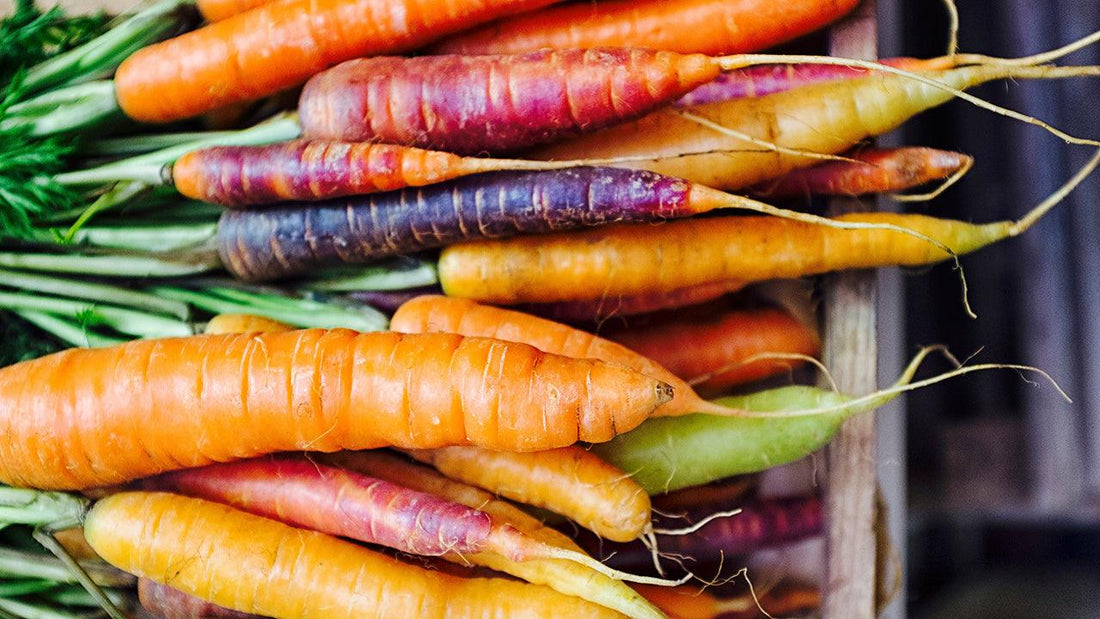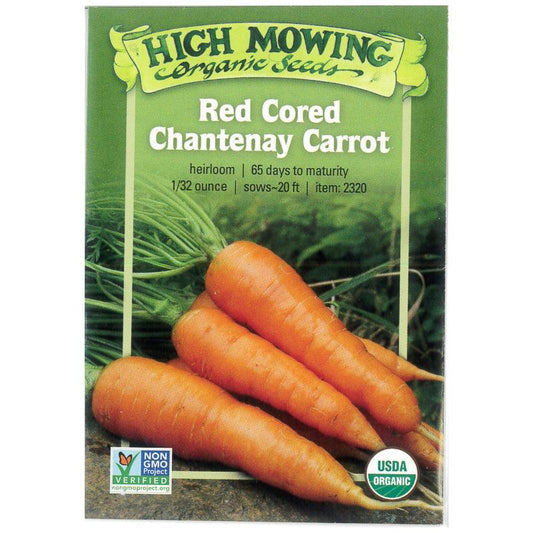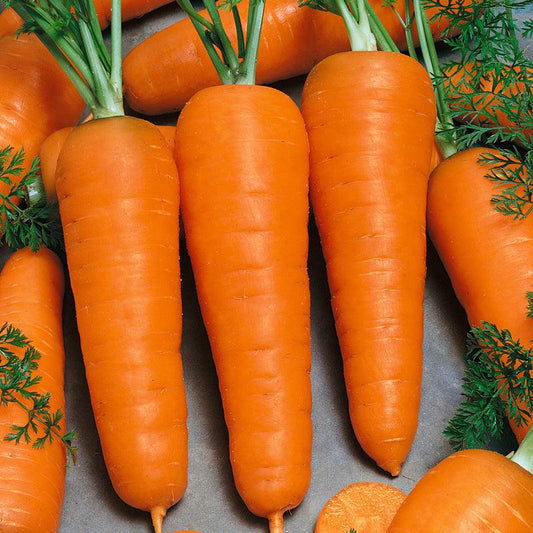Carrots are a great addition to the garden and fun for the whole family. Enjoy them fresh as a nutritious snack, or cooked, as a great addition to your winter soup.
If you're wondering when, exactly, is a good time to plant your carrot seeds, enter your last frost date (for spring planting) and first frost date (for fall planting) into our Seed Planting Calculator. It will calculate the best dates to direct seed or start seeds indoors.
You can also calculate when to plant your seeds by using the sowing information on the back of the seed pack and counting backwards from your last frost date on your calendar.
Carrot Types
Imperator: Grows up to 10,” orange, long and slender with a pointed tip, less sweet than other varieties. Examples are Kuroda.
Danvers: Grows up to 7,” orange, wider at the top with a pointed tip; longer than Chantenay. Danvers carrots have a strong flavor.
Nantes: Grows up to 7,” orange, short and blunt, very sweet, good for fresh eating. Nantes is more fragile that others with a shorter storage life
Chantenay: Grows up to 5,” deep orange, short and fat with broad tops and blunt tips, grows well in heavy soil, stores well.
Amsterdam: Grows up to 3,” thin and slender, good for early harvest, grows well in heavy soil. Example is the Little Finger.
Paris Market: Round, short, about 1½” in diameter. Example is the Parisian.
Purple: Wide variety of color intensity and shade with an orange or yellow core; very sweet with peppery tinge in some varieties.
Red: Red to purplish exterior with pink to orange core; usually sweeter than most varieties.
White: White coloration; thin to slender and mildly flavored.
Yellow: Hybridized from orange varieties for sweetness; yellow exterior and core. Example is Solar Yellow.
Growing Basics
Soil: Carrots prefer a soil pH of 6–6.8. Preferred 60–75°F (above 60°F for best germination). Tolerance 45–75°F. Amend heavy clay soils with compost and remove as many rocks as possible.
Air Temperatures: Considered a cool season crop developing best at 60–65°F.
Days to Emergence: 6–21 days, depending on variety and conditions.
Seed Longevity: if properly stored, the seeds should be viable for about 3 years.
Yield: Varies widely depending on variety as well as weather and water availability.
Spacing: 1–2” in rows 2’ apart
Companion planting:
- Incompatibility — dill, parsnips, coriander
- Companions — tomato, rosemary, sage, chives, radish, lettuce
Water Requirements: Consistent moisture. Sprinkle lightly daily to keep soil moist and not dislodge seed during germination.
Fertilization: Address amendments prior to transplanting into garden, supplementing per product label. Do not fertilize with high nitrogen fertilizers.
Planting & Growing

Sowing: Carrots are sown directly in the garden and a loose, rock-free soil is essential to success. Work soil to a depth of 12” and amend soil if needed (avoid manures). Sow seed ¼” deep, keeping in mind how much thinning will be needed to space 2” apart. For more even seeding you can mix your seed with sand, coffee grounds or vermiculite. Crusting of soil is a problem for seed germination, so you can cover with sifted soil, vermiculite, compost or Quickroot to help with seed emergence. For a continuous harvest, make successive plantings every three weeks. Begin as early in spring as frost dates allow about 10 weeks before the first frost date for fall harvest.
Carrots do not compete well with weeds, so keep weed-free during germination and establishment. Thin carrots to 2–3” between plants by snipping rather than pulling out seedlings to avoid damaging the root.
Keep evenly moist to avoid root forking, bitterness, root cracking or slow leaf development. Mulch around plants to help conserve moisture. Do not fertilize with high nitrogen fertilizers, this can lead to root branching.
Harvesting
Check the shoulders of the carrots at the soil line. Once finger sized they can be harvested by gently lifting from the soil (care should be taken with long varieties to not snap off tip). They can be stored in the ground until mature size or allow to remain into the winter if covered in a straw mulch.
Carrots will usually store 4–5 months in a root cellar at 33°F with a humidity of 90–95%. Twist off greens and remove excess soil (do not wash). Layer them so that roots do not touch in a box with sand and straw.
Common Pests & Diseases

Bolting: Plant goes to flower. Caused by prolonged exposure to temperatures below 65°F or to below freezing. Use row covers to protect.
Carrot Rust Fly: Root has tunnels that ooze soft material. Can use sticky traps (for monitoring) or an organic insecticide labeled for Carrot Rust Fly.
Leaf hoppers: Leaves turning yellow, wilting or curling up. Use beneficial insects, row covers or an organic insecticide labeled for leaf hoppers.
Failure to germinate/emerge: If temperatures are not optimal seed will not germinate. If they do germinate and the soil is allowed to crust over, they cannot emerge. Do not water heavily from overhead; even heavy rain can displace seeds or compact the soil.
Root-Knot Nematodes: Causes knobby distortions and stunted roots. Do not plant carrots in the same area for at least 3 years. Plant a non-host cover crop species such as wheat, barley, rye, or oats.
Slugs: Chew leaves. Hand pick at night, bait or set out saucers of beer or use an organic pesticide labeled for slugs.
Pest Control – IPM (Integrated Pest Mangament)
Integrated Pest Management (IPM) is an effective and environmentally sensitive approach to pest management that starts with the least invasive or impactful control methods and considers the use of chemical controls as the last step. For more information watch our Integrated Pest Management video.
Important to practice good cultural controls for pest management of carrots. Cultural controls such as removing plants after harvest (to avoid leaving food for insects to continue to multiply on), practice crop rotation (i.e. do not plant crops in same family, in the same area for 3 years), use row covers such as Agribon AG15 (cover before insects arrive or to protect against birds when plants are young).
Common Questions
Why are the tops of my carrots always green? If carrots get large enough for the shoulders to be exposed to sunlight they will green up. Mound soil up around the shoulders, but not over the greenery.
Where do my carrots disappear from my garden bed? If there is a whole in the ground deeper than your carrot, it is probably gophers or groundhogs. If it appears the carrot has been plucked, suspect deer, rabbits, opossums or humans.
What causes my roots to fork off into numerous tips? Obstructions in the soil usually just causes the tuber to warp out of linear growth, but excess nitrogen will cause it to fork. Uneven moisture levels can also lead to this growth formation.
How do I avoid over sowing seed and then having to thin more carrots than grow to maturity? Use a small hand seeder to space individual seed. Mix seed with sand, dry coffee grounds or vermiculite before sprinkling down the row. Sow carrot and radish seeds alternately. Radish will mature soon and take up the needed space between carrots while immature.
My carrots sometimes are more bitter than sweet? Temperature can cause carrots to get bitter. Hot or dry weather burns the sugars in the tubers. If nighttime temperatures reach over 60°F, this may occur so harvest what carrots are sizing up.
Definitions
Heirloom: Heirloom seeds come from open-pollinated plants that pass on similar characteristics and traits from the parent plant to the next generation plant. Heirloom vegetables are old-time varieties generally which have been in production since before WWII, and have been saved and handed down through multiple generations.
Hybrid: a cross between two or more unrelated plant varieties. The two different varieties are cross bred, resulting in a seed that carries one or more favorable traits (increased yield, uniformity, color, disease resistance.) Hybrid seeds are not GMO, as they are manually cross-bred, not genetically modified in a lab. Hybrid seed is often sterile or does not reproduce true to the parent plant. Therefore, never save the seed from hybrids.
Open Pollinated: generally refers to seeds that will “breed true”. When the plants of an open-pollinated variety self-pollinate, or are pollinated by another representative of the same variety, the resulting seeds will produce plants roughly identical to their parents. Genetic traits may differ only slightly due to variations created by local conditions.
GMO: Genetically Modified Organisms were genetically modified in a laboratory where DNA genes are extracted and mixed with other unrelated plants to improve characteristics. Saved seed will not always be viable and may be trademarked to prevent unauthorized use.




